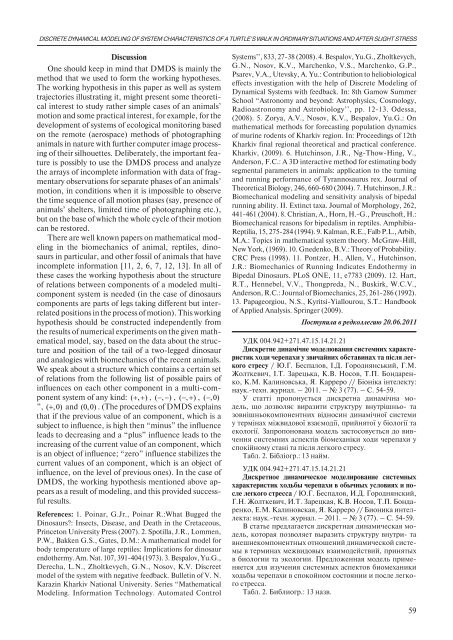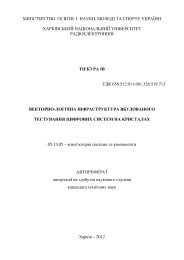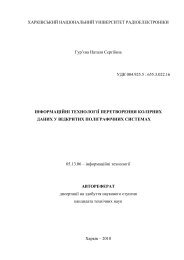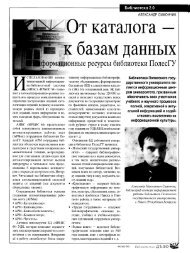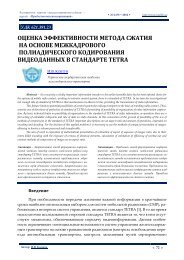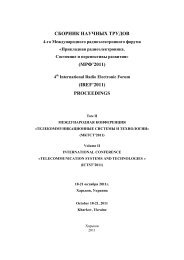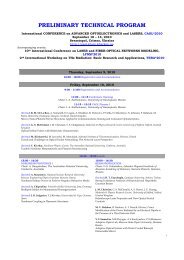информация, язык, интеллект № 3 (77) 2011
информация, язык, интеллект № 3 (77) 2011
информация, язык, интеллект № 3 (77) 2011
You also want an ePaper? Increase the reach of your titles
YUMPU automatically turns print PDFs into web optimized ePapers that Google loves.
DIsCreTe DYNamICal moDelING of sYsTem CharaCTerIsTICs of a TurTle’s WalK IN orDINarY sITuaTIoNs aND afTer slIGhT sTress<br />
Discussion<br />
One should keep in mind that DMDS is mainly the<br />
method that we used to form the working hypotheses.<br />
The working hypothesis in this paper as well as system<br />
trajectories illustrating it, might present some theoretical<br />
interest to study rather simple cases of an animals’<br />
motion and some practical interest, for example, for the<br />
development of systems of ecological monitoring based<br />
on the remote (aerospace) methods of photographing<br />
animals in nature with further computer image processing<br />
of their silhouettes. Deliberately, the important feature<br />
is possibly to use the DMDS process and analyze<br />
the arrays of incomplete information with data of fragmentary<br />
observations for separate phases of an animals’<br />
motion, in conditions when it is impossible to observe<br />
the time sequence of all motion phases (say, presence of<br />
animals’ shelters, limited time of photographing etc.),<br />
but on the base of which the whole cycle of their motion<br />
can be restored.<br />
There are well known papers on mathematical modeling<br />
in the biomechanics of animal, reptiles, dinosaurs<br />
in particular, and other fossil of animals that have<br />
incomplete information [11, 2, 6, 7, 12, 13]. In all of<br />
these cases the working hypothesis about the structure<br />
of relations between components of a modeled multicomponent<br />
system is needed (in the case of dinosaurs<br />
components are parts of legs taking different but interrelated<br />
positions in the process of motion). This working<br />
hypothesis should be constructed independently from<br />
the results of numerical experiments on the given mathematical<br />
model, say, based on the data about the structure<br />
and position of the tail of a two-legged dinosaur<br />
and analogies with biomechanics of the recent animals.<br />
We speak about a structure which contains a certain set<br />
of relations from the following list of possible pairs of<br />
influences on each other component in a multi-component<br />
system of any kind: ( + , + ) , ( −, − ) , ( − , + ) , ( −,0)<br />
”, ( + ,0) and (0,0) . (The procedures of DMDS explains<br />
that if the previous value of an component, which is a<br />
subject to influence, is high then “minus” the influence<br />
leads to decreasing and a “plus” influence leads to the<br />
increasing of the current value of an component, which<br />
is an object of influence; “zero” influence stabilizes the<br />
current values of an component, which is an object of<br />
influence, on the level of previous ones). In the case of<br />
DMDS, the working hypothesis mentioned above appears<br />
as a result of modeling, and this provided successful<br />
results.<br />
References: 1. Poinar, G.Jr., Poinar R.:What Bugged the<br />
Dinosaurs?: Insects, Disease, and Death in the Cretaceous,<br />
Princeton University Press (2007). 2. Spotilla, J.R., Lommen,<br />
P.W., Bakken G.S., Gates, D.M.: A mathematical model for<br />
body temperature of large reptiles: Implications for dinosaur<br />
endothermy. Am. Nat. 107, 391-404 (1973). 3. Bespalov, Yu.G.,<br />
Derecha, L.N., Zholtkevych, G.N., Nosov, K.V. Discreet<br />
model of the system with negative feedback. Bulletin of V. N.<br />
Karazin Kharkiv National University. Series “Mathematical<br />
Modeling. Information Technology. Automated Control<br />
Systems’’, 833, 27-38 (2008). 4. Bespalov, Yu.G., Zholtkevych,<br />
G.N., Nosov, K.V., Marchenko, V.S., Marchenko, G.P.,<br />
Psarev, V.A., Utevsky, A. Yu.: Contribution to heliobiological<br />
effects investigation with the help of Discrete Modeling of<br />
Dynamical Systems with feedback. In: 8th Gamow Summer<br />
School “Astronomy and beyond: Astrophysics, Cosmology,<br />
Radioastronomy and Astrobiology’’, pp. 12-13. Odessa,<br />
(2008). 5. Zorya, A.V., Nosov, K.V., Bespalov, Yu.G.: On<br />
mathematical methods for forecasting population dynamics<br />
of murine rodents of Kharkiv region. In: Proceedings of 12th<br />
Kharkiv final regional theoretical and practical conference.<br />
Kharkiv, (2009). 6. Hutchinson, J.R., Ng-Thow-Hing, V.,<br />
Anderson, f.C.: A 3D interactive method for estimating body<br />
segmental parameters in animals: application to the turning<br />
and running performance of Tyrannosaurus rex. Journal of<br />
Theoretical Biology, 246, 660-680 (2004). 7. Hutchinson, J.R.:<br />
Biomechanical modeling and sensitivity analysis of bipedal<br />
running ability. II. Extinct taxa. Journal of Morphology, 262,<br />
441-461 (2004). 8. Christian, A., Horn, H.-G., Preuschoft, H.:<br />
Biomechanical reasons for bipedalism in reptiles. Amphibia-<br />
Reptilia, 15, 275-284 (1994). 9. Kalman, R.E., falb P.L., Arbib,<br />
M.A.: Topics in mathematical system theory. McGraw-Hill,<br />
New York, (1969). 10. Gnedenko, B.V.: Theory of Probability.<br />
CRC Press (1998). 11. Pontzer, H., Allen, V., Hutchinson,<br />
J.R.: Biomechanics of Running Indicates Endothermy in<br />
Bipedal Dinosaurs. PLoS ONE, 11, e<strong>77</strong>83 (2009). 12. Hart,<br />
R.T., Hennebel, V.V., Thongpreda, N., Buskirk, W.C.V.,<br />
Anderson, R.C.: Journal of Biomechanics, 25, 261-286 (1992).<br />
13. Papageorgiou, N.S., Kyritsi-Yiallourou, S.T.: Handbook<br />
of Applied Analysis. Springer (2009).<br />
Поступила в редколлегию 20.06.<strong>2011</strong><br />
УДК 004.942+271.47.15.14.21.21<br />
Дискретне динамічне моделювання системних характеристик<br />
ходи черепахи у звичайних обставинах та після легкого<br />
стресу / Ю.Г. Беспалов, І.Д. Городнянський, Г.М.<br />
Жолткевич, І.Т. Зарецька, К.В. Носов, Т.П. Бондаренко,<br />
К.М. Калиновська, Я. Карреро // Біоніка інтелекту:<br />
наук.-техн. журнал. – <strong>2011</strong>. – <strong>№</strong> 3 (<strong>77</strong>). – С. 54-59.<br />
У статті пропонується дискретна динамічна модель,<br />
що дозволяє виразити структуру внутрішньо- та<br />
зовнішньокомпонентних відносин динамічної системи<br />
у термінах міжвидової взаємодії, прийнятої у біології та<br />
екології. Запропонована модель застосовується до вивчення<br />
системних аспектів біомеханіки ходи черепахи у<br />
спокійному стані та після легкого стресу.<br />
Табл. 2. Бібліогр.: 13 найм.<br />
УДК 004.942+271.47.15.14.21.21<br />
Дискретное динамическое моделирование системных<br />
характеристик ходьбы черепахи в обычных условиях и после<br />
легкого стресса / Ю.Г. Беспалов, И.Д. Городнянский,<br />
Г.Н. Жолткевич, И.Т. Зарецкая, К.В. Носов, Т.П. Бондаренко,<br />
Е.М. Калиновская, Я. Карреро // Бионика <strong>интеллект</strong>а:<br />
наук.-техн. журнал. – <strong>2011</strong>. – <strong>№</strong> 3 (<strong>77</strong>). – С. 54-59.<br />
В статье предлагается дискретная динамическая модель,<br />
которая позволяет выразить структуру внутри- та<br />
внешнекомпонентных отношений динамической системы<br />
в терминах межвидовых взаимодействий, принятых<br />
в биологии та экологии. Предложенная модель применяется<br />
для изучения системных аспектов биомеханики<br />
ходьбы черепахи в спокойном состоянии и после легкого<br />
стресса.<br />
Табл. 2. Библиогр.: 13 назв.<br />
59


